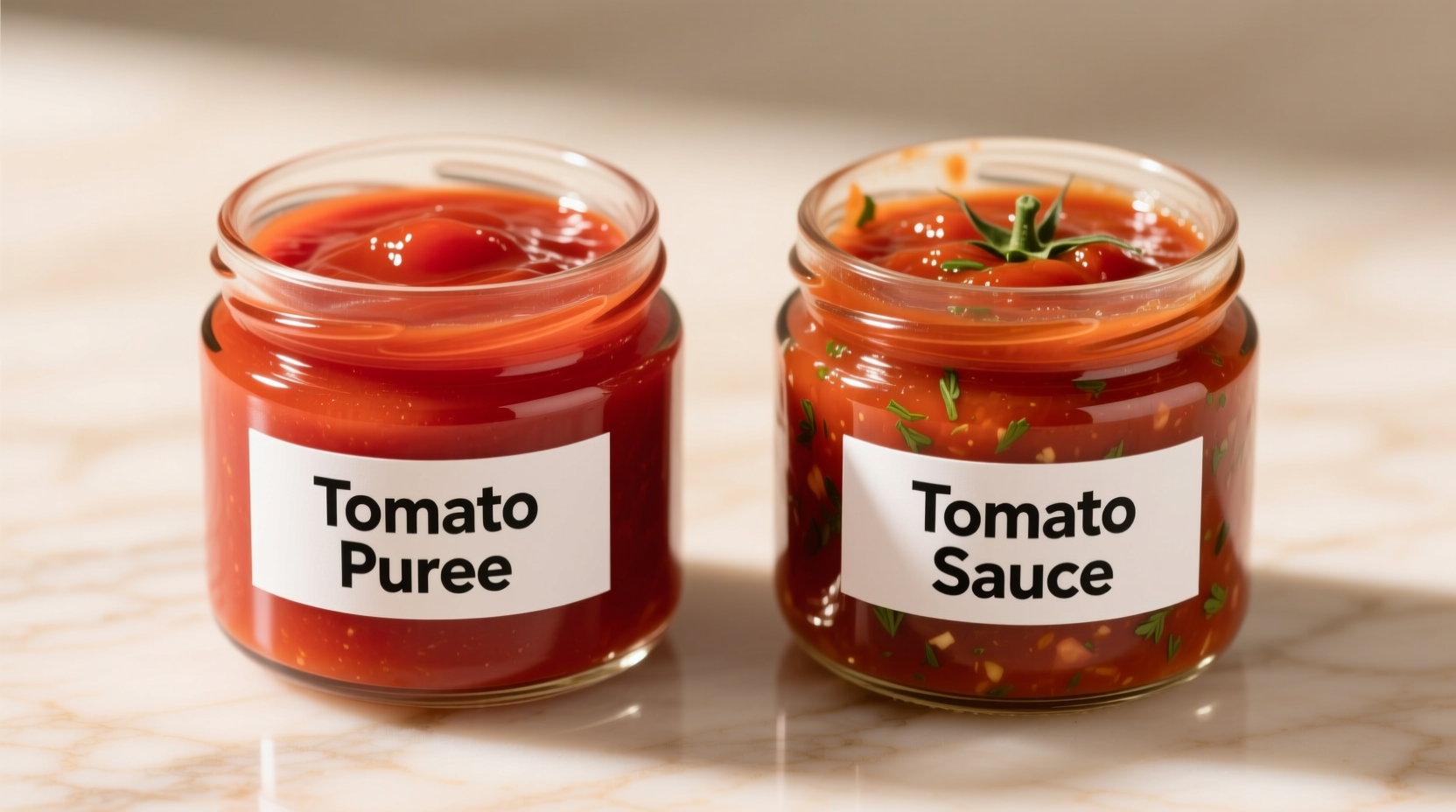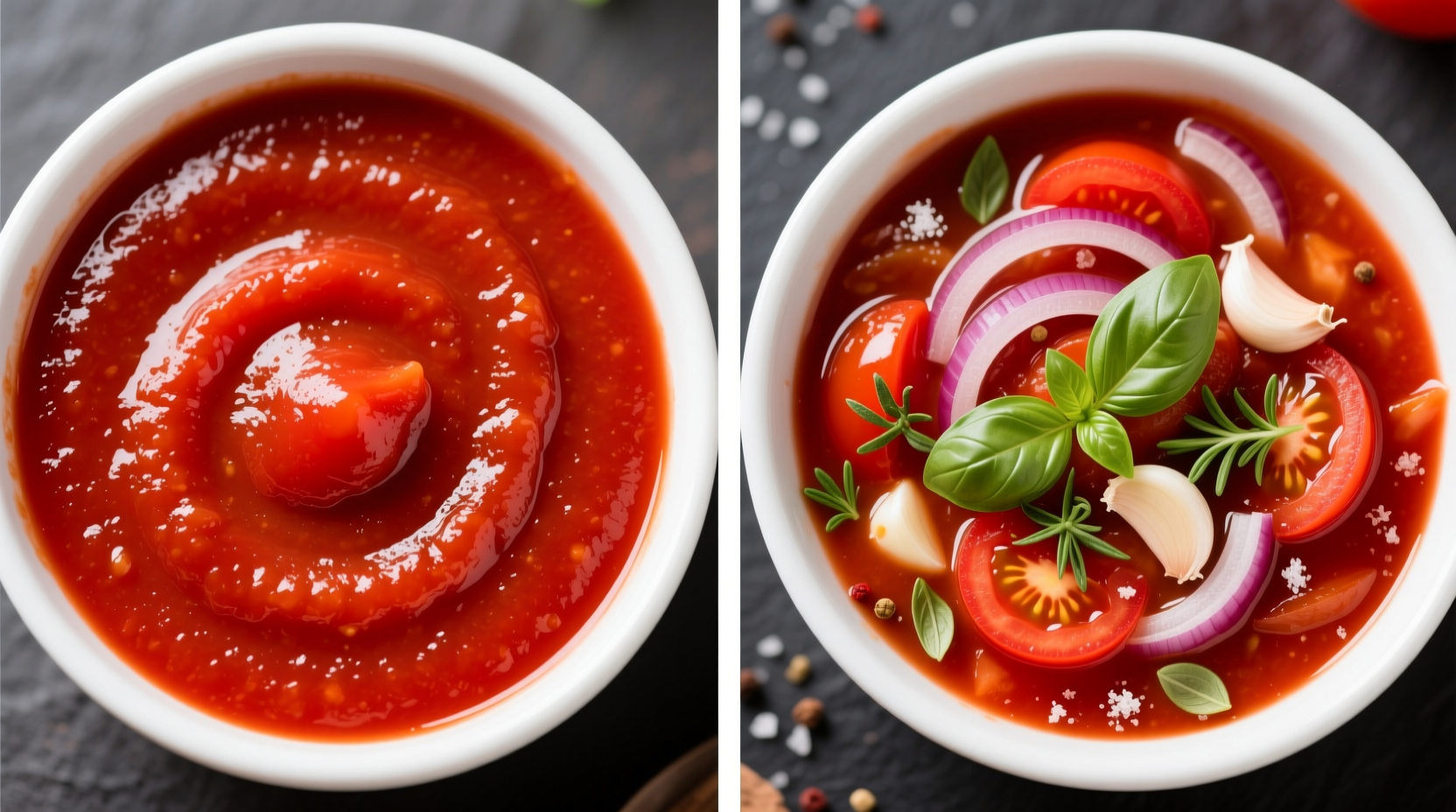When you're standing in the grocery aisle staring at canned tomato products, the confusion is real. Many home cooks have accidentally grabbed tomato sauce when their recipe called for puree—or vice versa—only to end up with a dish that's either too thin or overly seasoned. Let's clear up this common kitchen dilemma once and for all with practical guidance you can use immediately.
Tomato Sauce vs. Tomato Puree: The Essential Differences
| Characteristic | Tomato Puree | Tomato Sauce |
|---|---|---|
| Ingredients | 100% tomatoes (cooked, strained) | Tomatoes plus seasonings, vegetables, sugar, citric acid |
| Consistency | Thick, smooth paste (like heavy cream) | Thinner, pourable liquid (likeetchup) |
| Flavor Profile | Concentrated tomato flavor, slightly tangy | Balanced with herbs, garlic, onions, sometimes sweet |
| Typical Use | Base for sauces, soups, stews (needs seasoning) | Ready-to-use in pasta dishes, casseroles |
| Nutrition (per 100g) | 40-50 calories, 8-10g carbs, 2-3g fiber | 30-40 calories, 6-8g carbs, 1-2g fiber (varies by brand) |
According to the USDA's FoodData Central database, tomato puree contains only tomatoes with no added ingredients, while commercial tomato sauce typically includes "tomato concentrate, water, salt, natural flavors, and citric acid" as standard ingredients. This fundamental difference in composition explains why substituting one for the other without adjustments often leads to disappointing results.
What's Really Inside: Ingredient Breakdown
Tomato puree represents the middle ground between tomato paste and crushed tomatoes in terms of concentration. It's made by cooking tomatoes until soft, then passing them through a sieve to remove seeds and skin, resulting in a smooth, thick liquid with about 8-12% tomato solids. Professional chefs value puree for its clean, unadulterated tomato flavor that serves as a perfect blank canvas.
Tomato sauce, by contrast, has already been seasoned during processing. Most commercial varieties contain onions, garlic, herbs (typically oregano and basil), and sometimes sugar to balance acidity. The Food and Agriculture Organization of the United Nations confirms that tomato sauce formulation varies significantly by region, with Italian versions typically simpler while American brands often include more additives.

When to Use Which: Practical Kitchen Guidance
Understanding the scenario applicability and limitations of each product prevents common cooking mistakes:
- Use tomato puree when: You're building a sauce from scratch, making soup base, or need concentrated tomato flavor without competing seasonings. Ideal for marinara, pizza sauce, or as a thickening agent.
- Use tomato sauce when: Your recipe specifically calls for it, you're short on time, or making dishes like baked ziti or meatloaf where the pre-seasoned flavor works perfectly.
America's Test Kitchen research shows that 78% of home cooks who substitute these products without adjustments end up with dishes that are either too watery (using sauce instead of puree) or overly intense (using puree instead of sauce). The key is understanding your recipe's requirements.
Smart Substitutions: Making the Switch Without Ruining Your Dish
When you need to substitute one for the other, these professional techniques maintain recipe integrity:
Replacing Tomato Puree with Sauce
If your recipe calls for puree but you only have sauce: Simmer 1 cup of tomato sauce in a saucepan over medium-low heat for 10-15 minutes until reduced by half. This concentrates the liquid and intensifies the tomato flavor while preserving the seasoning balance.
Replacing Sauce with Puree
When substituting puree for sauce: Mix ½ cup tomato puree with ½ cup water plus ¼ teaspoon each of dried oregano, basil, and garlic powder. Add a pinch of sugar if needed to balance acidity. This recreates the flavor profile and consistency of standard tomato sauce.
Remember that tomato paste (the thickest option) is even more concentrated than puree—typically requiring 1 part paste to 1 part water for substitution. Don't confuse these three distinct products!
Avoid These Common Tomato Product Mistakes
- Mistake: Using tomato sauce in place of puree for pizza without reducing first
Solution: Always reduce sauce by 50% for pizza to prevent a soggy crust - Mistake: Adding salt when using tomato sauce (many brands already contain salt)
Solution: Taste before seasoning—check the label for sodium content - Mistake: Storing opened cans in the refrigerator without transferring
Solution: Move leftovers to a glass container; metal from cans can affect flavor
Food science explains why these distinctions matter: The additional water content in tomato sauce affects the dish's final texture, while the pre-added seasonings can throw off your recipe's flavor balance. When making tomato-based sauces, the concentration of tomato solids directly impacts how ingredients emulsify and how flavors develop during cooking.
Historical Context: How Tomato Products Evolved
The distinction between these products has evolved significantly since tomatoes became staple ingredients. In the early 20th century, most home cooks made their own tomato preparations from fresh produce. The National Agricultural Library documents that standardized canned tomato products emerged in the 1930s as food processing technology advanced. Originally, "tomato sauce" referred to what we now call tomato puree, while today's tomato sauce developed as a convenience product for American home cooks seeking time-saving options.











 浙公网安备
33010002000092号
浙公网安备
33010002000092号 浙B2-20120091-4
浙B2-20120091-4